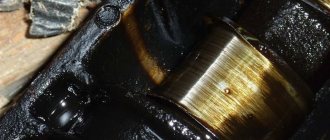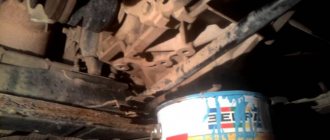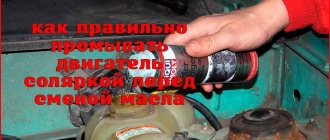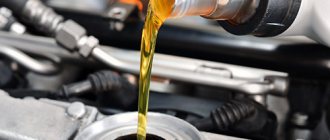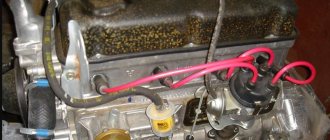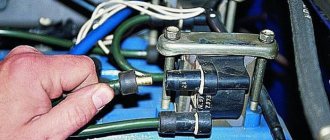One of the common mistakes made by car owners is filling the engine oil above the Max or Full level on the dipstick. The result can have serious consequences for both gasoline and diesel engines of such cars as Lada Vesta, Priora, Niva, Ford Focus 2, VAZ 2112/2114 and others.
Below we will look at what can happen if the oil is overfilled above the permissible level, and how to proceed to fix the problem.
First, let's talk about gasoline engines, and then we will separately pay attention to diesel engines. At the end we will also talk about motorcycles.
Make sure the oil level is correct
Before taking drastic steps, make sure that the problem really exists. To do this, you need to check the accuracy of the measurements again.
To avoid errors, make sure the following conditions are met:
- The machine is installed on a horizontal plane.
- Tire pressure is the same for everyone.
- The car is empty.
Particular attention should be paid to the temperature of the lubricant, which must be relevant for the test. Most often, manufacturers recommend taking measurements after 5-10 minutes from the moment the heated engine stops.
Procedure:
- Start the car.
- Let the engine run for at least 10 minutes at idle (until it warms up).
- Turn off the engine.
- Wait 2 – 5 minutes.
- Take a level measurement.
Some manufacturers recommend taking measurements “cold”. In such machines there are special marks on the probes for such measurements.
To carry out measurements, a probe is used, which is highly accurate and allows you to see an error of even 200-300 ml. This is why there is no need to use other measuring devices.
Note that inside the engine there is no more than 50% of the total volume that fits in the lubrication system, but this does not mean that you can pour an unlimited amount into the system; there is a limit to everything.
Why does overflow happen?
There are several reasons that can lead to overflow.
Random
In automotive practice, there is such a thing as an indelible residue - oil that remains in the system even after draining. Its volume ranges from 200 to 500 ml, but can be larger if the power unit is not fully heated.
When filling systems, the car owner fills in as much oil as the manufacturer recommends, and does not take into account the indelible residue. As a result, the level rises above the maximum level.
Deliberate
Some car owners believe that a slight excess is even good for the engine. It is believed that the power unit will still partially “eat” the excess. This is a false assumption that can ultimately lead to negative consequences.
During malfunctions
A common situation is when at first the dipstick shows the optimal level, but after some time the situation changes and it increases.
The reason may be the ingress of other technical fluids, for example, antifreeze or gasoline.
Diagnosing such a problem is very simple - just smell the smell of the lubricant, and also pay attention to its color.
In addition, when coolant gets into the oil, white exhaust gases appear, and at the same time the antifreeze level drops.
In older engines the situation is as follows:
- First, fuel enters the combustion chamber through damaged injectors.
- The fluid then seeps through the piston rings and into the crankcase.
The cause may also be damaged spark plugs that do not fire. As a result, unburnt fuel remains in the combustion chamber, also due to a broken gasket on the fuel pump.
Consequences of fuel getting into the oil sump:
- Loss of engine oil performance.
- A decrease in pressure in the system leads to oil starvation.
- Reduced compression.
- Excessive wear of parts of the cylinder-piston group, as well as their breakage due to heavy loads.
If the power unit is not too old, this situation can occur in the cold season, when you drive short distances and the engine does not have time to warm up.
There will be no consequences of a small amount of gasoline getting into the oil due to the rapid evaporation of the fuel, but the problem still needs to be solved.
The situation is more complicated if there is antifreeze in the oil. Typically, the cause of this is a blown cylinder head gasket.
In this case, excess “garbage” forms in the crankcase, and the properties of the lubricant deteriorate significantly. The result is accelerated wear of engine elements.
In this case, it is better to immediately go to a service station and use the services of a tow truck to protect the engine.
If you drive under your own power with such a malfunction, the situation may end in a major overhaul.
Incorrect oil change or topping up
Another reason, which partially overlaps with the first, is incomplete drainage of the lubricant during the replacement process due to haste.
In this case, the old place remains inside in the channels, pump, old filter that needs to be changed, and other elements. Subsequent filling of the required volume inevitably leads to an increase in the permissible level.
Vacuum oil pumping
How dangerous is excess oil?
Excessive consumption of fuel resources when oil is overfilled is explained by the fact that the excess viscous substance negatively affects the operation of the crankshaft and piston, creating additional resistance. The crankshaft rotates with difficulty and transmits reduced torque to the wheels. The performance of the car is significantly reduced. But the danger lies not only in excessive consumption of gasoline or diesel fuel. The level of the lubricant mixture above about will force the car owner to spend a long time under the hood, resuscitating the damaged engine.
In some cases, the engine simply fails, and replacing it costs a lot of money, effort and time. Think about what is more acceptable to you: monitor the condition of the car, the level of engine fluid, or pay considerable sums for the result of constant oversight.
The consequences of regularly pouring motor oil into the engine are expressed in the following negative aspects:
- the formation of carbon deposits exceeding several times the possible limit both on the pistons and inside the combustion chamber;
- rapid clogging of the muffler, which may require immediate replacement;
- excess is dangerous due to an increase in the amount of toxic exhaust products. When warming up a car in a garage, pouring oil into the engine contributes to the release of toxic substances that pose a danger to human life. If there is an excess of fuel and lubricant, the garage must be ventilated. It is unacceptable to be inside the garage while warming up;
- an increase in the engine’s need for fuel and lubricant, which negatively affects the financial side of the problem;
- excess contributes to an increase in pressure due to heating of a larger volume of liquid than expected. In this case, the seals suffer, they are simply squeezed out. Under pressure, oil begins to leak out of weak spots, the effectiveness of seals decreases, and the engine compartment becomes dirty;
- excess amount of engine fluid gets onto the spark plugs, which significantly reduces their service life;
- There is a risk of fuel and lubricants getting into the engine, which disrupts the normal operation of the unit.
If, with an increased amount of motor oil, condensation or moisture gets into the heart of your car, the result can be fatal: the unit will fail due to corrosion inside it. Once in the combustion chamber, excess lubricant negatively affects the quality of the air-fuel mixture. This leads to loss of dynamic properties and instability in the operation of the internal combustion engine.
This is interesting: What cars were and are in Donald Trump's collection: an impressive list!
Is a slight overflow acceptable?
The category of minor overflow refers to the situation when the oil level is higher than Max or Full by up to 10 mm. In this case, you should not count on serious consequences. Some car owners complain about a decrease in dynamics, but this is a false sensation.
Speaking in numerical terms, an excess of 100-200 ml is not terrible, but an overflow of 0.5-1 liters, as a rule, becomes a serious problem for the engine.
It is worth considering that even with a slight excess, the “gluttony” of the motor increases, and the excess lubricant “burns out” very quickly. In this case, the residues settle on the rings, cylinder walls or in the form of soot in the catalyst.
What can an elevated level lead to?
Exceeding the oil level above the permissible norm can lead to the following consequences:
- Reduced power level.
- Increased fuel consumption as the load on the crankshaft and pistons increases.
- Bubbling of lubricant by the crankshaft, which leads to foaming and an increase in the level of gases in the oil above the permissible level of 7%. The result is the appearance of knocking noise from hydraulic elements: tensioners, supports, pushers.
- Increased oil consumption.
- Blue smoke may appear from the exhaust system.
- The crankshaft flywheels run out against the oil, the latter foams, and the life of the crankshaft decreases.
In addition to those discussed above, other problems are possible:
- starting difficulties;
- the appearance of carbon deposits on engine elements;
- reduction in oil pump life;
- deterioration of the power unit;
- ignition problems;
- contamination of the catalyst and muffler;
- failure of spark plugs;
- improper operation of the engine crankcase ventilation system (EGR);
- the appearance of toxicity in the exhaust and other defects.
Exceeding the volume of lubricant is especially dangerous on older cars due to wear of the CPG and an increased volume of crankcase gases. The latter capture excess lubricant and carry it to the engine intake. This, in turn, leads to increased consumption and excessive exhaust smoke.
A turbocharged engine is also afraid of excessive amounts of oil, which in some models can get onto the walls of the compressor scroll and harden there.
As a result, the compressor wheels will touch the hardened deposits, increasing the load on the shaft bearings. They will wear out quickly and the turbine will fail.
Consequences of “oil starvation” of the drive
You should not drive a car with low oil level. The crankshaft bearings of modern cars are represented by a friction pair consisting of a crankshaft journal made of hard material and a liner made of soft material. The engine mixture is supplied under pressure into the gap between the liner and the neck. Under normal operating conditions, this gap is completely filled with oil, which prevents direct contact of the journal with the liner. When the oil pressure is low, the surfaces of these elements come into contact - shiny, polished areas are formed on the liners. This situation will not lead to destruction of the bearing if the contact of the parts is short-term, plus the temperature on the surface of the liners is not high.
We recommend: Cars with the most expensive maintenance!!!
A further reduction in the supply of engine mixture and an increase in the load on the power unit will increase the contact area of the crankshaft journal with the liner, and the temperature of their surfaces will increase. After some time of operation of the motor with a low level of lubricant, the layer on the surface of the liner will melt, and the hot material will fall on the surface of the shaft journal. Plus, the molten material will be squeezed out under load to the edges of the liner. Then there are two possible scenarios:
- The motor will operate at low speeds, with a light load - the bearing shaft will jam due to welding of the liner material to the shaft journal.
- Working at high speeds, the motor will overcome the resistance force generated by the influx of molten material - the rate of destruction of the liners will increase.
When the drive stops, the overheated parts of the power unit will gradually cool. When parts made of steel cool down, they will acquire a shade characteristic of the oxidation reaction.
The liners are thin-walled parts; their melting leads to deformation and an increase in the clearance in the bearing. The increased clearance is accompanied by a bearing knock that occurs when the shaft and liner come into contact at the bottom and top dead center of the piston. A clearly audible knocking sound occurs in the engine.
A low oil level causes overheating of the lower head of the connecting rod, the material from which it is made loses its original strength - the connecting rod breaks in any part of the lower head. Excessive overheating reduces the strength of the connecting rod bolts; they become deformed or break. If a bolt breaks, heated to a high temperature, or the lower head of the connecting rod falls into the space between the crankshaft and the stationary wall of the engine, the load inside the block is very large, with its help a fragment can pierce the block wall. The fragment, falling under the counterweight of the crankshaft and oil screen, forms a hole in the oil pan.
A reduced amount of oil inside the engine reduces the volume of lubricant that gets onto the cylinder walls; the situation is aggravated by the ingress of small particles into the cylinder-piston group, formed when the internal drive parts are destroyed - scratches form on the cylinder walls.
An insufficient amount of oil in the oil pan forms “oil fog” inside the engine - splashing of oil droplets on the rotating parts of the engine, followed by their separation into smaller ones, resembling fog. As a result, the internal elements of the motor have an oily appearance, especially visible in the lower part of the drive.
What to do if you overfilled the oil above the maximum
If the oil level exceeds the norm, study the appropriate operating section for your car. The easiest way is to go to a service center and pump out such a volume so that the level is between the Min and Max marks.
Many service stations offer an express replacement service, when lubricant is pumped out through the dipstick tube or filler neck using special devices.
You can do the work yourself and to do this, use one of the following ways:
- Open the drain plug and drain some oil. Be careful to pour off only the excess portion. After this, measure the level.
- Pump out the oil through the dipstick tube. To do this, use a special or medical syringe for 20 cc (the first is sold in car dealerships, the second in pharmacies), a rubber tube (dropper). When choosing this option, be careful not to allow foreign objects or debris to get inside. Otherwise, it may damage the motor.
- The same can be done through the filler neck, but the length of the tube must be longer and this cannot be done in all cars; you will need special equipment, which is available at every service station.
Also, to pump out oil, you can use special kits, which include an electric pump and tubes.
Below is a table with filling volumes for some brands of cars.
| car brand | Volume, l |
| Priora | 3,2-3,4 |
| VAZ 2114 | 3,5 |
| VAZ 2112 16 valves | 3.5+0.3v oil filter |
| Kalina | 3,5 |
| Lada Granta | 3.2 for cars with manual transmission and 4.4 for cars with automatic transmission |
| Lada Vesta | 4.4, and for AMT – 3.2 l |
| Niva | 3,75 |
| Ford Focus 2 | 3,5 |
Methods for eliminating overflow
How to fix the problem if the engine oil level is high? There are several ways to eliminate excess motor fluid.
Medical syringe and dropper
Draining oil using a syringe
With the help of simple devices that are available for free sale, you can get rid of overflow. You will need a tube for transfusion of a chemical solution and a regular medical syringe.
The operating principle is as follows:
- the end of the dropper hose must be connected to the syringe;
- the other end of the tube should be inserted into the opening of the oil dipstick;
- collect excess oil.
In practice, sometimes drivers wrap the dropper tube with electrical tape for greater weight and stability when placing it in the meter opening. Situations have also been noticed when, instead of a medical syringe, the role of a pump is played by a person’s mouth.
The operation is considered complete when the required oil level is reached.
Drain hole in the crankcase
Excess motor fluid in the system can be eliminated by draining the engine. To carry out this operation, you need to have unnecessary rags and a free, clean container. The container can be a basin or half of an old canister. The operating principle of ridding the system of excess drops of engine oil is constructed as follows:
Engine oil drain
- secure the car under an inspection hole or on an overpass;
- turn off the car, all operations are carried out on a cold engine. This is done to avoid accidental burns when draining a hot consumable;
- remove the drain plug;
- a pre-prepared oil tank must be placed under the drain;
- draining is carried out until all excess lubricant is removed;
- the drain plug is fixed back into the engine crankcase;
- lubricant is added to the required value.
Motorcycles
The problem of exceeding the oil level is relevant not only for cars, but also for two-wheeled mechanized vehicles, as well as ATVs.
This applies to the vehicles listed above, both four-stroke wet-sump power units and two-stroke ones (in which oil is added to gasoline).
For 4-stroke engines
Each engine has a special breather installed to remove crankcase gases. While driving, excess oil (especially on a bad road) will come out through it. As a result, normal loss of lubrication occurs.
The remaining problems are similar to those listed above.
For 2-stroke engines
The same consequences as discussed above are relevant here, but we are no longer talking about exceeding the level.
For such engines, it is important to maintain the correct proportion of 1 to 50. This means that for 5 liters of gasoline you need to add about 100 million of engine lubricant.
Compliance with this rule is very important, because the appearance of excess oil leads to the following problems:
- The appearance of soot.
- Throwing candles.
- Difficulty starting the motorcycle engine.
- Malfunctions on the road (the engine periodically stalls).
- The appearance of bluish smoke from the exhaust system.
